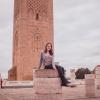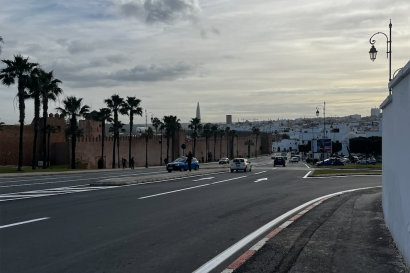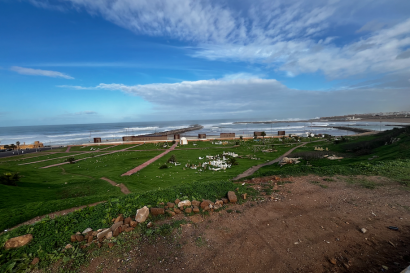There is surely no better way to experience a culture than a celebration like a wedding, and I was lucky enough to be able to participate in two such events here in Rabat.
A traditional Moroccan marriage has three steps, often spaced out over a span of months. First is the proposal: the young man and his family come to the house of the young woman's family, bearing many expensive gifts. The families share a dinner and the young man asks for the young woman's hand in marriage. This is an opportunity for the two families to see how well they would blend together.
Next comes the engagement, or khutuba, a giant celebration for the extended families of the bride and groom that almost feels like a rehearsal for the actual wedding. I attended the khutuba of my host cousin Oumaima and the extravagant party lasted for three days and two nights. Because of religious custom and tradition, I can't share any pictures of adults, which leaves me to give you only glimpses of the celebration, through photos of the food, the props and costumes, and the children.
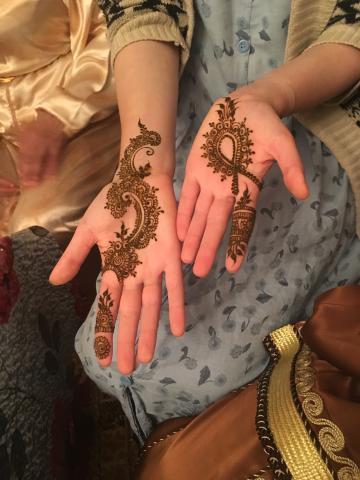
The first night begins with henna for the bride and all her female relatives.

It's the second night that the party really begins, with food, music, gifts, and everyone dressed in beautiful caftans and takshitas.

The bride and groom arrive and everyone gathers around, cheering and sprinkling rose water on them. There is a chant that goes "aslaaaat wa salaaaaam Allah rasuuulilaaah ilaaa jah ila jah sid na Mohammed Allah m3a jah l3ali!" (all praising the glory of God and the Prophet) and is followed by a high-pitched, yodeling ululation.

The couple sits on a throne-like couch and gifts are presented before them: jewelry, clothing, shoes, and sweets.

There is singing! There is dancing! Lots of photos are taken, but here is what I can show you: three lovely cousins dressed up in their wedding finery.

And at long last dinner! Chicken and olives, followed by lamb and prunes, and then a course of fruit.

Everyone settles in for the night as the men in another room begin to listen to Koran. The whole experience was wild, colorful, dizzying, and disorienting as the whole family moved around me in a language that I barely speak. Despite that, Moroccans make their love and welcome known across all language barriers.
The final celebration is the wedding itself. IES Abroad Rabat throws a mock Moroccan wedding for the students, and we voted on a bride and groom (many congratulations to the happy couple, Yasmeen and William). Our host families dressed us up and gave us traditional dishes to bring to the party where we listened to a Moroccan wedding band and danced with our professors. Among all of this, we also learned some of the steps of a traditional Moroccan wedding ceremony.

We skipped what is arguably the most important part of the ceremony, the signing of the marriage contract. This is what is required for a couple to be considered legally married. Of course, even if it's a fake wedding, the dancing was still real! See if you can spot the bride above in a crown and her first dress of the night: traditional dark green and gold, worn to receive henna.

The bride made her second grand entrance of the night in a magnificent white wedding gown to be carried on an ameriya, a ceremonial basket that is definitely a step up from the chair at an American wedding. My host sister told me that young Moroccan girls dream all their lives about the moment that they will get to ride in an ameriya at their own wedding.

The groom, too, gets a turn to ride around above the guests.

The next part of the ceremony is the couple together in the ameriya, where the groom gives the bride a kiss upon the forehead, and she does likewise.

Ceremony over, we stopped for food (usually a many-course meal, but for our purposes only pastries and tea) and photographs, and then got back onto the dance floor! Whereas at the Moroccan engagement, it was a room full of women dancing, the IES Abroad wedding had everyone dancing together—including, in this picture, two of our Arabic professors!
I feel so lucky to have been able to be a part of these two celebrations, to see the traditional engagement and the wonderful IES Abroad party. The formula of marriage is changing in Morocco, as young people start dating more and more before marriage and the rules of what is considered appropriate behavior and contact between young men and women are broken more often, especially by the wealthier urban youth. That being said, arranged marriages are still common enough in poorer and more rural areas, and it is still illegal for a Muslim woman to marry outside of her religion or for a Moroccan to marry someone of the same gender. Morocco's family code (Moudawana) was updated in 2004, a move that outlawed child marriage and updated the laws surrounding divorce, among other things. As the idea of marriage and relationships continues to change in Morocco, I am grateful to now be able to contextualize these ideas in the beautiful celebrations that surround them.
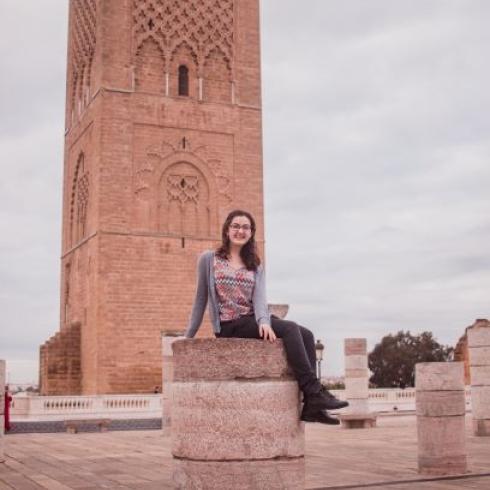
Sarah Mamlet
<p>My name is Sarah, and I'm from New England but I study psychology (and math, and religion, and everything else) at Vassar College in the Hudson Valley. When I'm not doing schoolwork, you can find me singing in a choir, at ballet class, or binge watching TV shows with my friends.</p>


